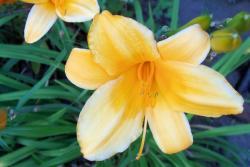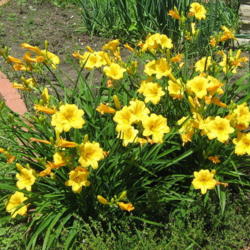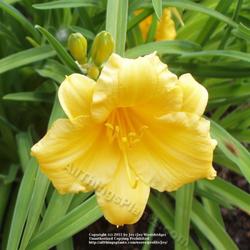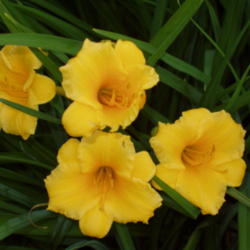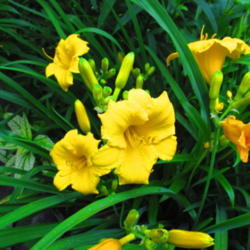Bonehead said:OK all you daylily afficionados... could you explain what reblooming means? I have only a few daylilies. The first one I ever got was a chunk from a friend, who told me it was just plain Stella. Whenever I read about Stella D'Oro, the main attribute seems to be the reblooming quality. I am unclear what exactly that means. Two distinct bursts of bloom? Keeps blooming on the same stalks? What? I am beginning to wonder if my Stella is even Stella... The color and shape seem OK, but mine is taller than usually described (not unusual in my region for most plants) and the reblooming thing further confuses me.
Deb,
Rebloom is variable, it can come in the form of "instant rebloom", where a single fan of a daylily will push a primary scape and a secondary scape. This secondary scape will sometimes start blooming before the primary scape finishes. Sometimes these are followed by a third, or more, although I have only seen a third scape in my garden a couple of times. As I remember, instant rebloom wasn't that common back in the early 80's. The rebloom I remember seeing back then was a secondary scape which would emerge later in the season, most of the time so late that the last few blooms were cold-damaged. Some cultivars would do this fairly reliably, with others it was a random event which seemed to be dependent on culture. Then, in the mid-to late 80's some cultivars started coming out of Florida which were throwing instant rebloom, and even a third scape from the same initial fan. I think the first time I saw this in my garden it was from My Darling Clementine and Ed Brown. This extra "vigor" may have been the result of a trend among Florida hybridizers to discard seedlings which failed to bloom within 9 months of sowing. I put vigor in quotes because some of these plants will markedly decrease in size over the season, I assume because they've thrown a lot of energy into flower production.
Stella was the first, or maybe the first notorious "continuous bloomer", and it was commonly assumed that it simply kept reblooming throughout the season. As it became more widely grown, people started to pay more attention to how single fans of it performed, and someone advanced the theory that Stella only rebloomed once, but that even small, new divisions were capable of blooming and reblooming as well, so what we're seeing with Stella is a bloom scape, rebloom from that scape, division, and as that new fan matures, bloom and rebloom again. This theory fits in pretty well to what I have seen—a lull in bloom after the first display.
As to what is and what is not Stella de Oro, it's really tough to tell any more. Stella clumps tightly, and reseeds generously, and the seedlings look so much like Stella, that it would be difficult to tell them apart. Also, Stella de Oro might be the most tissue cultured daylily ever, and some people feel that tissue-culture increases the number of mutations in propagation. Stella was such a hot commodity that many unscrupulous nurserymen would slap the name "Stella-something" on any old reblooming yellow or gold daylily, or would sell something similar, saying "it's just as good as Stella", a bit of information which might be soon lost or forgotten as the plant was handed over the fence to a neighbor.
Your image—if it accurately represents what you see day-to-day—suggests that you don't have the genuine article. Heck, I bought the genuine article (not tissue cultured), and it's been in a clump so long that I wouldn't swear that I don't have seedlings in it as well. One thing breeders used to say about breeding with Stella de Oro was, 'You tend to get a lot more Stella".
If your picture is representative of what you see on a regular basis, I'd say there's a good chance you have something else. Several of the images in the ATP database look suspect as well. More than most other plants, climate can significantly alter the shape and color of a daylily, so unless a database image is obviously wrong, I wouldn't suggest removal, but what I will do is link to the ones that look the most like the Stella I grow. My evenings are typically cool, and the flower will open differently in warm, humid regions, but there are a few idiosyncrasies that help identify it. For me, the petals are fairly wide, and have a tendency to recurve, so as soon as the petals clear the sepals, they fold back, but the midrib area is fairly stiff, holding the end of the petal "up" a bit. The very tip does recurve though, resulting in a distinctive, blocky petal shape. The scape will be thin and wiry, with all of the buds clustered at the tip. And the flower's definitely gold, not yellow.
